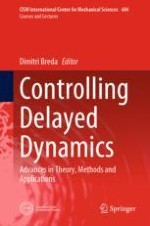2023 | OriginalPaper | Buchkapitel
Counting Characteristic Roots of Linear Delay Differential Equations. Part I: Frequency-Sweeping Stability Tests and Applications
verfasst von : Silviu-Iulian Niculescu, Xu-Guang Li, Arben Çela
Erschienen in: Controlling Delayed Dynamics
Aktivieren Sie unsere intelligente Suche, um passende Fachinhalte oder Patente zu finden.
Wählen Sie Textabschnitte aus um mit Künstlicher Intelligenz passenden Patente zu finden. powered by
Markieren Sie Textabschnitte, um KI-gestützt weitere passende Inhalte zu finden. powered by
